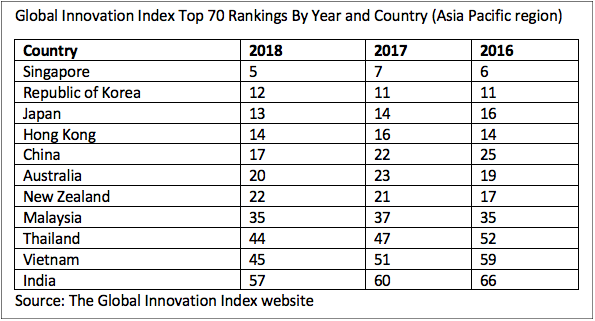Silence is not always golden
By Sharmila Ganapathy August 17, 2018
- Malaysia has produced few world-class inventions or unicorns
- Innovation organisations are not doing their job

THE Financial Times’ lexicon says innovation “involves producing new products and services, new business models and new or improved methods for producing goods or services.
“Innovation is more than invention. It feeds commercial success, normally boosting efficiency and/or profits.”.
Malaysians are no strangers to innovation, either. It was a Malaysian who invented the USB drive. Another Malaysian invented the rubber stamp clone machine and a Malaysian also invented the IV flush device.
However, these devices were invented years ago and it also must be noted that not only has Malaysia produced few world-class inventions since, we have not given the world unicorns (apart from Grab).
Where did Malaysia go wrong? Somewhere along the way, despite the government pumping in billions into various innovation-related organisations, it has failed to produce the world-class innovations that it aspires to.
Statistics don’t lie
Let’s look at the global measure of innovation and how Malaysia ranks compared to its Asia Pacific counterparts. The Global Innovation Index (GII) published annually by Cornell University, Insead and the World Intellectual Property Organisation, is a ranking of world economies’ innovation capabilities and results.
According to the GII website, it “aims to capture the multi-dimensional facets of innovation and provide the tools that can assist in tailoring policies to promote long-term output growth, improved productivity, and job growth.”
The following are the rankings for the past three years:

At first glance, it might seem that Malaysia’s ranking has improved somewhat. We did jump from 37th to 35th place this year. But if you dig a little deeper, Malaysia was actually in 31st place in 2011. In 2013, we were at 32nd place.
So if you thought that we are doing well, we actually aren’t. Let’s not forget that Singapore has been in the top ten for years and while one can argue that Singapore is a developed country, one can also argue that that’s not an excuse because Malaysia has had plenty of time and much investment in innovation organisations to boost innovation.
Additionally, Malaysia should be benchmarking itself against neighbours such as Singapore in order to step up innovation. Furthermore, our less-developed neighbours Thailand and Vietnam have consistently improved in terms of rankings and are not far behind.
Are innovation organisations really needed?
What really bugs me is that despite there being in existence at least five high-profile innovation-related government-funded organisations, today Malaysia is nowhere on the global innovation stage.
Let’s take a closer look at these five innovation organisations, simply by looking at their websites and Googling results on media coverage about them:
1. National Innovation Agency Malaysia
Otherwise known as Agensi Inovasi Malaysia (AIM), this was a statutory body set up under the previous administration in 2010 to “jump start wealth creation through knowledge, technology and innovation to stimulate and develop the innovation eco-system in Malaysia.”
Interestingly, the current government has dissolved this body, which is expected to cease operations in 2020. The agency’s website was last updated in May 2017 and the media room page appears to be a dead link.
According to AIM, all operations at the agency are going on as planned pending further instructions from the Prime Minister’s Department and/or Cabinet for future directions.
Furthermore, apart from a Google search of news related to the agency, all searches turned up events, most co-organised with other agencies, but no real concrete news of results.
Pre May 2017, AIM’s website was migrated to a more secure server due to some prior hardware failure. Some images and documents could not be recovered, the broken links are being addressed and fixed accordingly, AIM said.
The agency also said that the website is regularly updated with AIM’s initiatives via their AIM Reporter section (https://innovation.my/aim-reporter/) - the latest being an update on 16 August, 2018, about AIM’s education initiative to roll out the Genosis Programme for 10 pilot schools -https://innovation.my/aim_reporter/genosis-programme-to-catalyse-new-lea... also on their social media pages, namely:
AIM also shared that through its wholly-owned subsidiary PlaTCOM Ventures Sdn Bhd which was set up in 2014 in collaboration with SME Corporation Malaysia, it has been providing end-to-end facilitation services from concept to commercialisation and links to early stage financing.
To date PlaTCOM Ventures has:
- 190 Intellectual Property Rights being transferred from various research organisations to industry in the form of technology licenses;
- 143 SMEs admitted to the High Impact Programme 2 (HIP2) for commercialisation;
- 40 projects commercialised – total fund of RM18 million granted and the 40 SMEs have generated a total sum of RM33 million in revenue. This is a return of investment of about 83%.
[Ammended for purposes of clarity]
2. Malaysian Global Innovation and Creativity Centre (MaGIC)
Perhaps the most high-profile of them all, MaGIC was founded in 2014 and has been credited with giving funding, as well as running accelerators and coaching/networking programmes and events for startups in Malaysia.
Media reports have said that it is one of the government funds under review for its relevance, although nothing has been officially confirmed yet.
Feedback from the entrepreneurial community on MaGIC has been generally positive, although even MaGIC has not been able to produce a cohort of Malaysian-born unicorns or world-class Malaysian companies to date.
3. Malaysia Innovation Foundation
Also known as Yayasan Inovasi Malaysia, this government agency (now parked under the Ministry of Energy, Technology, Science, Climate Change and Environment), was founded in 2008 “to promote and champion innovation”.
Although the website is relatively up-to-date, the inventions featured in the media centre are either quite niche or unremarkable.
There is no news of any of these inventions winning international accolades or awards, and they seem targeted at a small audience or market. The same results came up from a Google search result of the foundation.
4. Malaysia Innovation Hub
This non-profit institution was set up under the Ministry of Higher Education and its mission is “to be the leading innovation commercialisation centre in Asia”.
The media centre of the website was last updated in 2016, which makes one wonder what it has achieved since then. A Google search result showed that the agency was last featured in the media in 2016. Time for an audit, perhaps?
5. Global Science and Innovation Advisory Council Malaysia
Established in 2011 (also by the previous administration), this council was chaired by the former Prime Minister and its secretariat is the Malaysia Industry-Government Group For High Technology (MIGHT).
Its objective was to function “as a sounding board to improve and optimise Malaysia’s capabilities in the field of Science & Innovation.”
According to the MIGHT website, council members comprise “selected Malaysian ministers, national and global corporate leaders, Nobel Laureates, eminent global academia as well as researchers.”
Unfortunately, that is the extent of information you’ll get about who the actual council members are or what the achievements of the council have been to date, because the website was down at the time of writing.

In summary, none of the above organisations apart from MaGIC appear to be doing anything to truly improve the entrepreneurial ecosystem in Malaysia.
For innovation to be truly innovation, there needs to be an element of commercialisation involved and the other four agencies seem not to have managed to achieve that at all.
What to do about it
While I think that it is great to have organisations that foster and promote innovation, the true innovators are entrepreneurs and youth and this is why organisations such as MaGIC should be allowed to continue.
The other four organisations, in my opinion, deserve a swift end to put a stop to duplication of government-funded innovation organisations. Throughout history, the greatest innovations have come from individuals, not governments.
Hence it doesn’t make sense for the current government to continue funding such agencies that don’t produce results.
If the current government wants to do a better job of encouraging innovation, they should listen to the entrepreneurs and youth and help them either through educational and/or financial means. For that’s the way to build a truly innovative society.
Related Stories:
Khazanah aims for innovation, tech in GLCs with Transformation 2.0
New Zealand’s healthtech innovators eye partnerships in Malaysia
MaGIC’s first female-centered Pre-Accelerator Bootcamp Demo Day
For more technology news and the latest updates, follow us on Facebook, Twitter or LinkedIn


